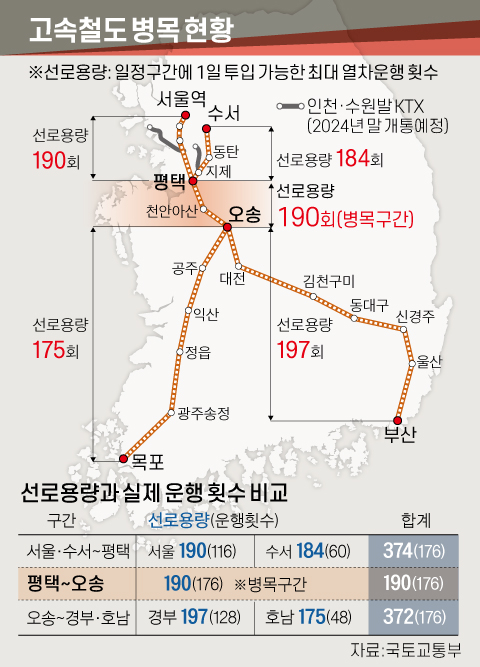It is expected that the two-track construction project of the’Pyeongtaek-Osong’ section, which is causing the bottleneck of high-speed trains, will be delayed by at least 2-3 years. This is because the Ministry of Strategy and Finance began reviewing the adequacy as the project cost increased significantly due to the late addition of rescue facilities for passenger evacuation and rescue in case of emergency.
Late addition of passenger evacuation and rescue facilities
Ministry of Equipment, reviewed when cost increased by 190 billion
High speed train bottleneck seems to be prolonged
According to the Ministry of Land, Infrastructure and Transport and the railroad industry on the 17th, the Ministry of Information and Transportation and the Korea Development Institute (KDI) have been looking into the adequacy of the’Pyeongtaek-Osong Double Track Project Plan’ since October last year. The project to open a new double-track tunnel under the 45.7 km section between Pyeongtaek and Osong has a total project cost of KRW 3.77 trillion and the goal is to be completed by 2024. In the meantime, it was not successful due to lack of economic feasibility, but was selected as a preliminary feasibility study exemption project in January 2019, and it became possible to promote it.

High-speed rail bottleneck status. Graphic = Reporter Kim Joo-won [email protected]
Currently, the high-speed trains KTX and SRT departing from Seoul-Yongsan Station and Suseo Station meet near Pyeongtaek. In addition, the high-speed trains that left Busan and Mokpo merge at Osong. However, in the section between Pyeongtaek and Osong, where high-speed trains rush, the capacity of the track is only half of the required amount, creating a bottleneck. The solution is to increase the capacity by installing an additional double-track railway between Pyeongtaek and Osong. However, he was caught in rescue facilities such as a rescue platform in preparation for an emergency situation. An additional 190 billion won will be added to install this facility in the basement of KTX Cheonan-Asan Station. This is the reason why the Ministry of Materials and Materials began to review the adequacy. An official from the Ministry of Land, Transport and Maritime Affairs said, “It was planned to use the dead pit that was installed during construction as an evacuation facility, but it was pointed out that separate measures were needed, and according to the results of analysis, we added a rescue facility.
The Ministry of Land, Infrastructure and Transport predicts that the review will end in the first half of this year. However, business delays seem inevitable. An official from the railroad industry predicted that “even if the review is over, the construction will start in two to three years at the earliest, considering the basic plan establishment, basic design, and detailed design period, and the completion will be in 2027 or 2028.”
If the project is delayed, there will be a number of obstacles to the operation of KTX from Incheon and Suwon, which is scheduled to open at the end of 2024. KTX departing from Incheon and Suwon plans to operate trains 18 times a day (one way basis), but due to the lack of tracks, it is inevitable to significantly reduce it for a considerable period of time. In addition, it is pointed out that it is difficult to avoid the inconvenience of train users in many ways because the number of high-speed trains departing from Seoul Station, Yongsan Station, and Suseo Station must be reduced in order to operate a part of the KTX departing Incheon and Suwon. Min-tae Kim, head of the Ministry of Land, Infrastructure and Transport, said, “As expected, the completion will not be delayed that much,” and “we are preparing a measure.”
Transportation reporter Gap-saeng Kang [email protected]
